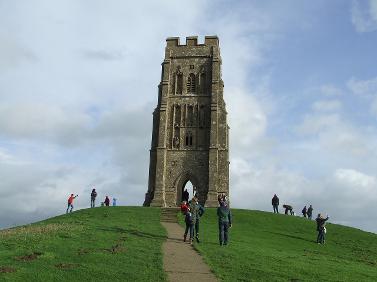Mabon ap Modron
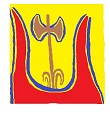
Compiled and
Presented By
Gary Smith
Mrdn - The Architect
August, 2013
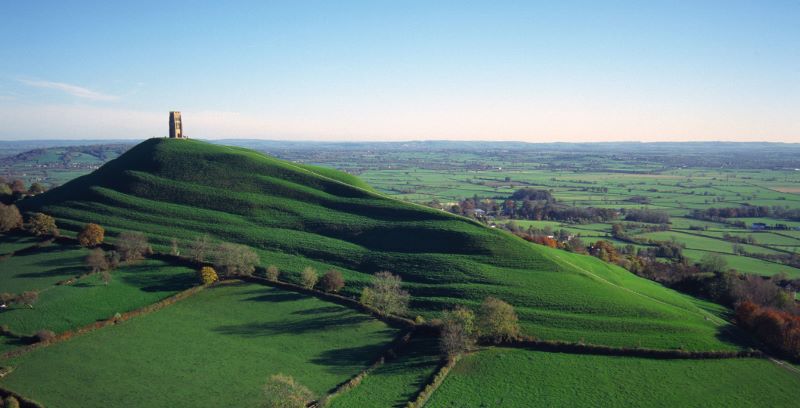
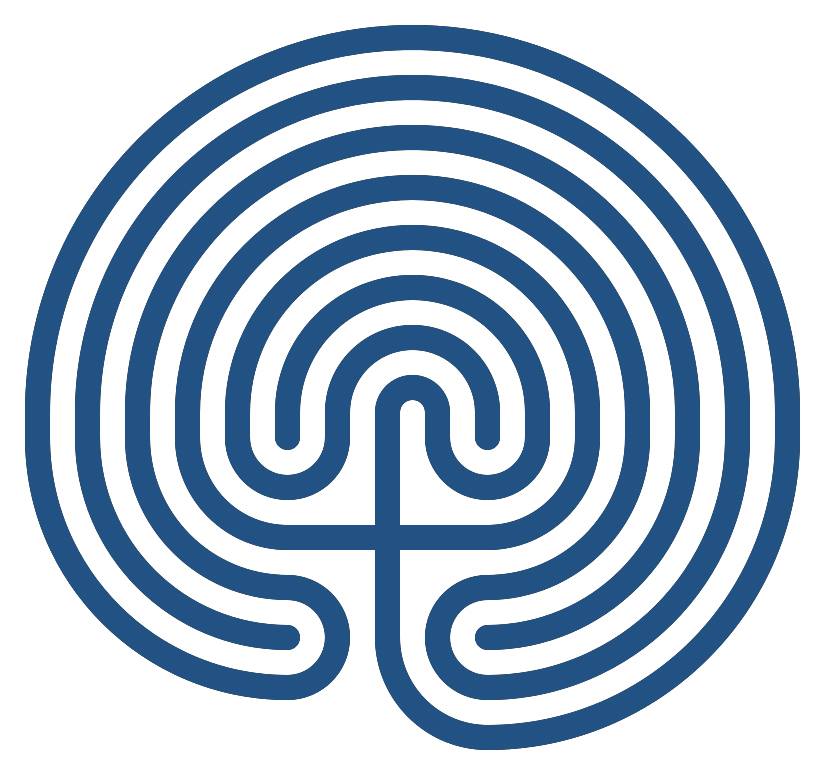
The Cretan Spiral Labyrinth
The Idaeans
Mountain of the goddess
Minoan Tor pagan.
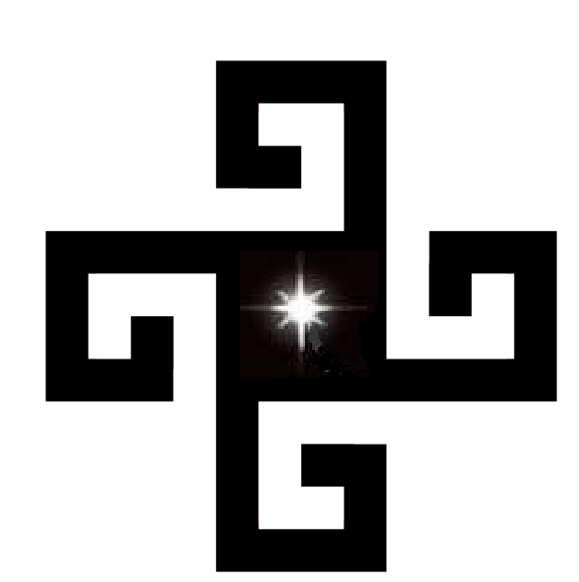
The left-facing symbol is called a Sauwastika and symbolizes the labyrinth and the night. The star represents Asterion (starry) and is another name for the Minotaur.
The Tor
The Horns of Consecration.
The Labyrs.
The Idaeans were Matriarchal?
The 7-Fold Labyrinth.
During a visit to Somerset England in 1983, I took a trip with my Father to Glastonbury, to climb the Tor, and see the remnants of St. Michael's church, a roofless tower, on top of a 518 foot hill on the outskirts of this small market town. While walking around the Tor, we noticed terraces cut deep into the side of the hill, and we later learned that the terraces were part of what is believed to be an ancient pathway from the Bronze age, running around the hill, and conforming to the design of The Labyrinth, the Cretan spiral of Minoan legend.
The design of the Labyrinth is very old. This spiral is so far flung it's not even considered to be of Minoan invention. The same maze can be found as the chief sacred image of the Hopi people in Arizona, called the "Mother and Son." The cross at the centre represents the Sun as well as a child being held by the mother. Later in the same year, I happened to come upon an excellent book, called the "Avalonian Quest" by Geoffrey Ashe, who looked into this enigma of the spiral on the Tor.
He proposed that two local deities were worshipped here as Mabon ap Modron. These are however not names. They are titles, and they mean "Divine Son, son of Divine Mother," and another connection it would seem to the sacred image of the Hopi. Ashe believes that these deities were Apollo, and his mother Leto. The British equivalents being Arthur and Morgan le Fay equated with the same story of Aeneas the wounded Trojan prince that was healed by Leto with Artemis in the temple at Troy, just as the wounded Arthur is received by Morgan le Fay who is Modron in her Avalonian realm.
The Minoan system of writing seems to be big on recording inventories in their palaces, sadly though, very little can be found on their history or mythology that could shed light on what the Labyrinth actually meant to the Minoans. There is a myth that the Tor is hollow suggesting an Underworld connection, perhaps this is where the Minoans stored their library?
With the myriad of myth, and conjecture surrounding the spiral it makes it is difficult to know, what if any of it would mean to the Minoans. The Labyrinth itself, is very silent, and not knowing its true origins prevents any real prospect of comprehending its actual purpose. The design of the Labyrinth is curious, it's not a spiral in the usual way, it has seven clear backward and forward circling until you reach the centre.
Does the design of the Labyrinth relate to something important?
With this in mind, I considered using an alternative approach, to gain new insights - what if, the Minoans encoded their beliefs within the Labyrinth itself, using the esoteric nature of numbers. If so, would it be possible to understand the meanings of the numbers derived from it?
As I read the Tarot, I decided to borrow the meanings of the Archetypes, used in the Major Arcana of the Tarot, as a kind of numerology if you will, of card numbers, and pictures that describe the allegorical nature of the cosmos.
Looking at the Labyrinth, the first Key number is obviously 7 as it is a septenary maze. The second Key number is 28. I calculated this number using the arms of the Cross at the centre and multiplying
4 x 7 = 28.
What does the number 28 mean? At first, I thought it might refer to the Moon, the number of days it takes to orbit the Earth. Unfortunately, I was unable to find a Moon goddess to relate this to, so I had to abandon this avenue of enquiry. If not the Moon, then what else could it be? I looked at all the numbers I had derived from the Labyrinth, and connected them to each other as best I could, by which time I was referring to this as the "Equation," and pursued a number of ideas over the years in various mythologies, Welsh, Celtic, Greek, and Arthurian Lore, Merlin etc., which again only ever hinted at any real answers.
Merlin or the welsh Myrddin which looks like Meridian to me, is reputed to be the builder of Stonehenge as there is a 14th century CE image of a giant helping Merlin to place a lintel on top of the uprights from a manuscript of the Roman de Brut by Wace and always struck me as a child to be the equivalent of Daedalus the builder of the Labyrinth.
It would be a long time before I would understand the meaning of 28. It was not until I came across another amazing book in 2013 that the number 28 finally made sense, "The Lost Empire of Atlantis" by Gavin Menzies. In his book he suggests that Crete was the fabulous city of Atlantis that Plato wrote about, and Stonehenge was built by the Minoans in order to use the stars to navigate by, and travel to America in search of Copper to make Bronze.
The Minoan civilisation came to an abrupt end in 1450 B.C.E for unknown reasons after recovering from an earthquake, and a massive Tsunami from the cataclysmic eruption of a volcano on the Island of Thera now called Santorini, and according to recent ice core testing the volcano erupted between 1627 and 1600 with tree ring data the volcano erupted between 1600 and 1525 BCE, although some testing also puts the eruption at 1625. Stonehenge came to be abandoned around 1628. His book suggests two important conclusions. If the Minoans built Stonehenge, then in all likelihood the Labyrinth on the Tor would have been built by the Minoans as well, and if they did indeed go to America, it would explain the Hopi connection to the maze and their stories of meeting white brothers. With this new avenue of enquiry, I turned my attention to Minoan Crete for the first time to see what else it might reveal.
There is a Minoan fresco found in 1973 on the Island of Santorini in a building designated as Xeste 3 at Akrottiri, depicting a young woman gathering Saffron. Saffron was used medicinally by women to ease menstrual pains. Opium has been known for millennia to relieve pain and its use for surgical analgesia has been recorded for several centuries. The Bell goddess on the right shows her hair adorned with what could be poppy-capsules and her closed eyes suggests sedation? The fresco was discovered decorating a room called the "Lustral Basin," an obsolete term now and referred to as an Adyton, a Cultic room, in which it is believed that young girls were initiated into the rituals associated with menstruation and childbirth.
Menstrual pains, the menstrual cycle?
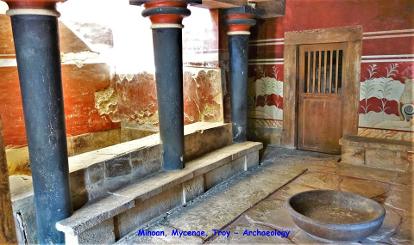
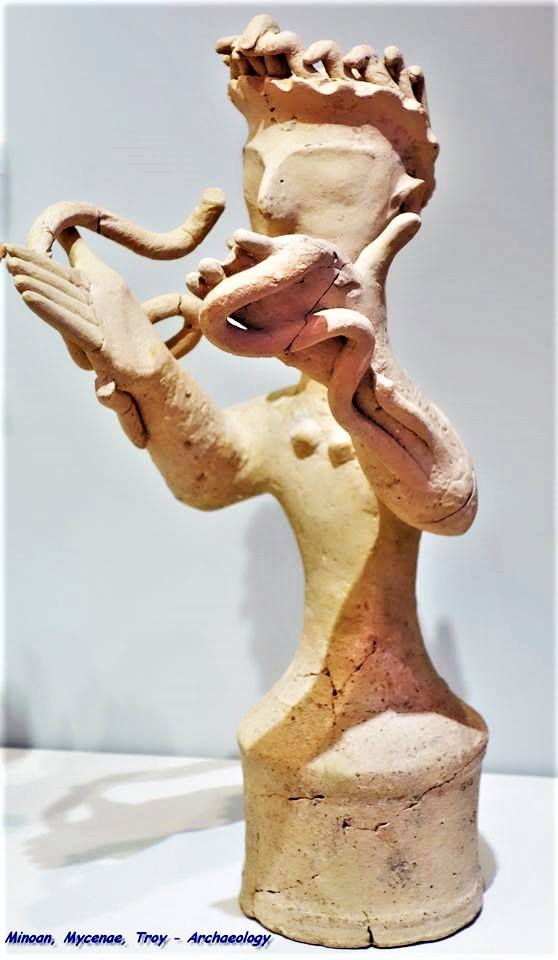
The sunken portion of the room to the left of the camera is the Adyton in the palace at Knossos.
Figurine of the goddess with snakes on upraised arms 1350 -1250 BCE
I knew goddess worship was central to Minoan culture, and after careful examination, the number 28 is without a doubt a reference to the average days in a woman's menstrual cycle.
The number 28 is represented by 2 x 8 which equals 16 and 2 + 8 which equals 10.


4 x 7 = 28 represented by cards 16 and 10.
The other key numbers are -
4 + 7 = Card 11.
3 x 4 = Card 12.
3 + 4 = Card 7.
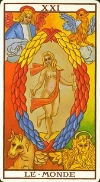
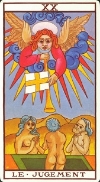
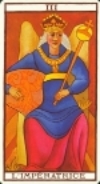
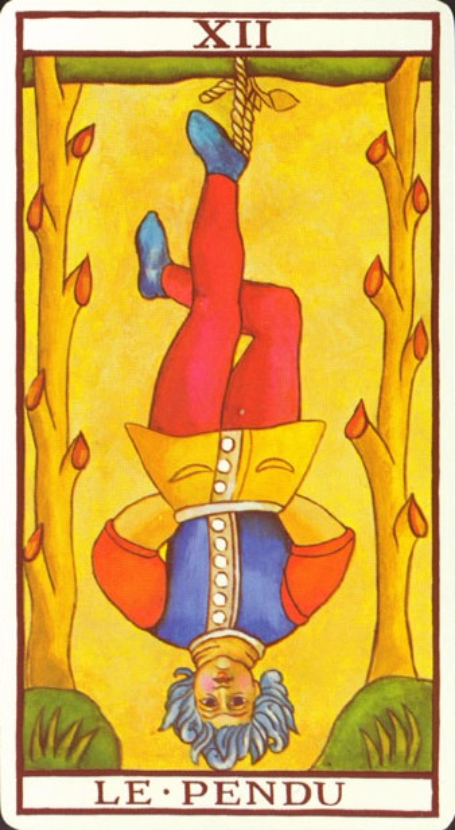





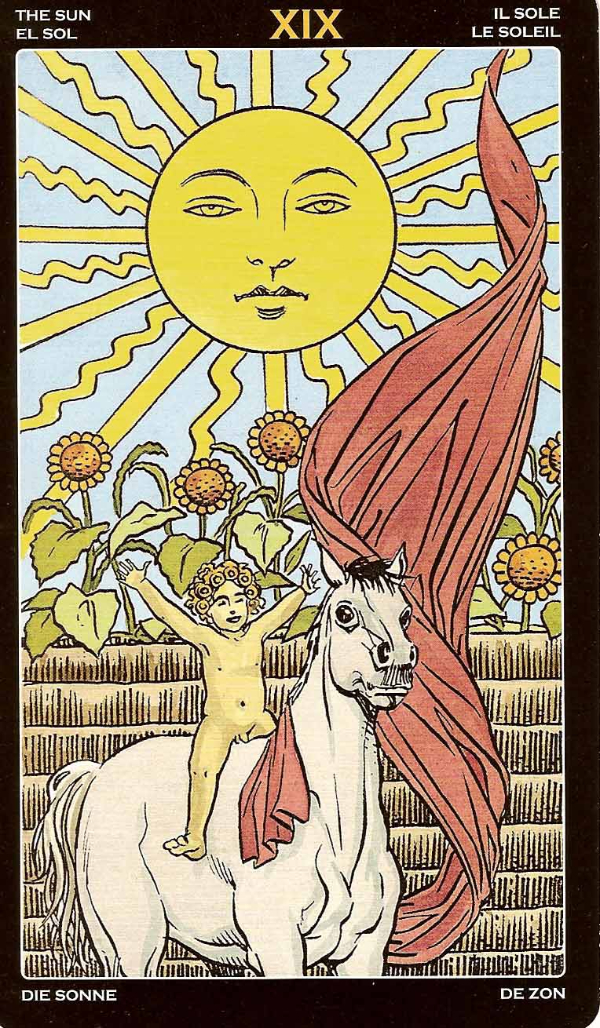

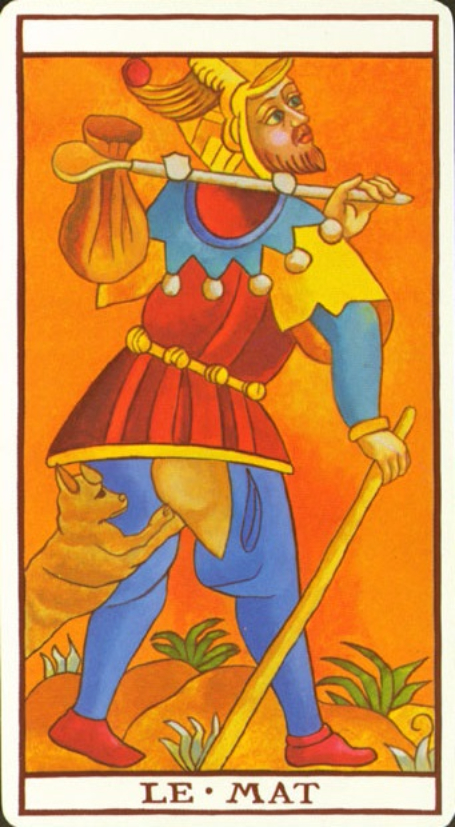
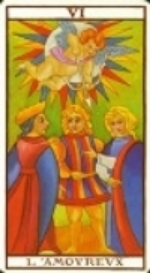
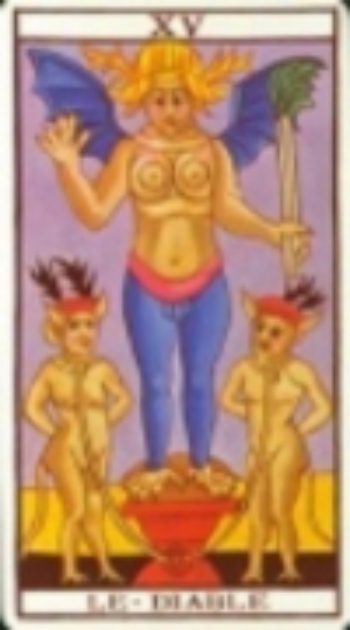

The rest of the cards are related by association, and taken from key numbers by adding and multiplying the values of the higher cards together to become what I would call an association card, to provide further indications of what the key numbers mean to the Labyrinth.
Card 11, and by association (1 + 1) = 2 The High Priestess. (1 x 1) = 1 The Magician.
Card 19, is by association from card 10 The wheel of Fortune.
Card 10, and by association (0 x 1) = 0 The Fool. (1 + 0) = 1 The Magician.
Card 16, and by association (1 + 6) = 7 The Charioteer. (1 x 6) = 6 The Lovers, and by association is card 15 The Devil.
Card 7, and by association is card 16 The Lightening Struck Tower.
I will discuss card Twelve, and its associations later.
The Wheel of Fortune, and the Lightening Struck Tower represent the two reproductive cycles of a woman.
The four main phases of the Menstrual cycle are:-
- Menstruation
- The Follicular phase
- Ovulation
- The Luteal phase

The two reproductive cycles are, the 'OVARIAN' cycle that effects what happens in the ovary, and the 'MENSTRUAL' cycle that effects what happens in the uterus. During ovulation, the egg is released from the ovary, leaving behind the tissue that surrounded it. This tissue is referred to as the 'YELLOW BODY,' or more specifically the Corpus Luteum.
Card Two, is the right ovary, and Card Eleven represents the Corpus Luteum as the yellow body.
Card One represents the connection between cards Eleven, and Ten, and the ovarian cycle. The Magician is called the 'little man of the Moon' as magic was associated with the Moon. In Astrological terms the sign of Cancer was ruled by the Moon as the Gate of Man through which souls entered the body on Earth. It is interesting to note that in both these cards the figures are wearing a hat, in the shape of an infinity symbol, and is similar in shape to the female reproductive organs.
When the egg is released during ovulation, from its follicle, it is captured by finger-like projections on the ends of the fallopian tubes called the fimbriae. The fimbriae sweeps the egg into the tube. The Corpus Luteum releases a combination of hormones to maintain the thickened lining of the uterus, waiting for a fertilised egg to attach itself to the wall of the uterus.
If pregnancy does not occur, the Corpus Luteum withers and dies, usually around day 22 in a 28 day cycle. The yellow body disintegrates, and progesterone levels steadily drop to the point where the uterine lining cannot be sustained. The lining is shed, and menstruation begins.
The meaning of card *Sixteen is very descriptive of this process (and by association with card seven) lasts on average seven days. Card *Six and by association with card Fifteen (the Serpent) represents the blood that is shed. In Minoan culture the Snake Goddess holds a snake in each hand. The snake periodically sheds its skin. The Hopi people of North America performed an annual Snake dance to celebrate the union of a Antelope Youth (a Sky Spirit) and a Snake Girl (an Underworld Spirit) to renew the fertility of nature. This is a prayer to the spirits of the clouds, the thunder and the lightning, that the rain may fall on the growing crops.
*The Lightning Struck Tower - 'Breaking down existing forms to make way for new ones' - S.R.Kaplan.
*The Lovers - 'Putting to the proof, speculating, examining' - S.R. Kaplan.
Note the similarity of card twenty-one with the snake goddess.
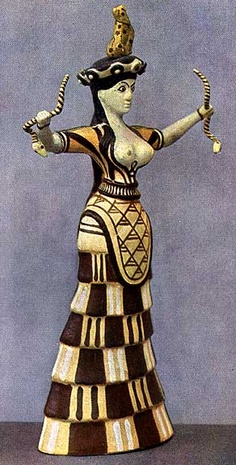
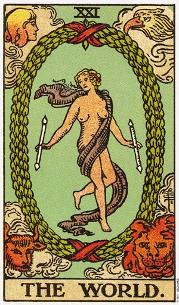
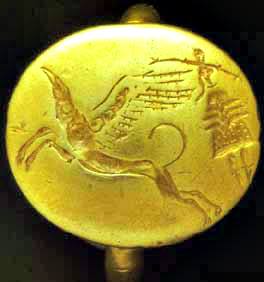
The Goddess Therasia and a
Griffin.
If fertilisation does occurs, the role of the Corpus luteum changes (symbolised by the second Magician card) by maintaining its hormone functions until the placenta (represented by the Zero card, The Fool) develops sufficiently to secrete the necessary hormones.
A successful pregnancy results in a child, and is represented by card 19, the Sun. Card Seven is a composite number of 3 + 4 and according to Cornelius Agrippa; it is the Pythagoreans Vehiculum of man's life, the four elements and three of the soul.
Card Twelve is 3 x 4 and represents the Uterus. Card Three is 1 + 2, the Empress, and, the left ovary. Card Two, The High Priestess is 1 x 2 = 2 and the right ovary as before. Cards 20 and 21 are by association of cards 3 and 2 and represent the Breasts of a woman. It can take up to twelve months after giving birth before the Menstrual cycle resumes, and it was believed by the ancient Greeks that Menstrual blood became Breast milk during this time.
The Tor also has a very female characteristic of an underground stream (Chalice Well) known as the Red spring situated at the foot of the hill because of the Iron content of the water. The Minoan Mother Earth Goddess Rhea, daughter of Gaia, her name means 'ease or flow,' and is depicted in a fresco on a tripartite platform guarded by a griffin, and being offered a Crocus flower by a blue monkey, as part of the Menstruation and childbirth mysteries she must have presided over. Laura Perry has recently put forward a new theory as to who this Goddess is, which she believes to be the Sun Goddess Therasia.
Exactly how a sun goddess would come to be on a fresco dedicated to these mysteries was a mystery in itself, as you would expect a moon goddess usually to be the case. I considered the possibility that she could be the Idaean equivalent of Aphrodite being a goddess of love, and the nature of the room. However, it is has been put forward in the book 'Mother of the Sun' by Patricia Monaghan, that many of the sun goddesses of europe and asia appear to have originally come from Siberia, such as the example of Artemis who entered Greece as a foreigner, and is thought to have come from the Altai mountains in Siberia. Offerings would arrive regularly at Delos the shrine she shared with her brother, and were believed to have come from the Hyperboreans, the mythical people who lived beyond the north wind. Aristeas a priest of apollo set out to find them, and ended up in the Altai region, although he never did find them, he thought they were in the area, as the land was rich in gold and guarded by griffins. The Altai mountains do have gold deposits, and the hyperboreans would have been the siberian shamanism that Artemis would have belong to.
So it's possible the reason for the sun goddess appearing on this fresco is from female shamanism. The goddess is receiving saffron which is yellow in colour (Sun) and the griffin guards gold, and is her totem animal. Saffron has the process of drying out and turning a red colour which would reinforce the menstrual aspect of this room
As the sun goddess is accompanied by a griffin, I've decided to change card 19 from another deck to reflect this.
To continue -
The two Magician cards, and the fimbriae, mentioned earlier which sweeps the egg towards the fallopian tube with finger-like projections is very reminiscent of the fourth act of creation in Hopi myth.
The creator Taiowa commanded Sotuknang with the creation of life. He went to the world that was first to host life in the beginning, and there he created 'Spider Woman,' and he gave her the power to create life. Spider woman then took some earth, and mixed it with saliva to make two beings Poqanghoya, and Palongawhoya. They were sent to the poles of the Earth to keep it rotating.
Ariadne keeper of the Labyrinth is linked with the constellation of Corona Borealis. In Welsh myth, the Goddess Arianrhod is also associated with this constellation. According to some, Arianrhod is a Moon goddess, although Levannah Morgan says she is a Sky goddess; her name means Silver wheel, and refers to the rotation of the sky around the Pole star. Her uncle Gwydion recommended her for a special function at court, as a royal foot holder, and used a magical test to prove her virginity, (which was a requirement of the position) by having her step over a magical staff. As she steps over the staff, two children she has conceived, but as yet shown no sign of pregnancy, suddenly tumble out of her. One of them is an embryonic blob. The other is a sea creature, a Merman called Dylan. He runs off to the sea, and swims away. Arianrhod after this unfortunate ignominy also swiftly departs, leaving behind the blob that is taken by Gwydion, and placed inside a chest at the bottom of his bed to gestate very quickly into a young man, who will eventually be known as Lleu Llaw Gyffes - equated with the Irish god Lugh, and identified as Mabon by Nikolai Tolstoy in his book "The Quest for Merlin."

The Uranus Connection.
This is the first part of decoding the Labyrinth. The next part deals with another change to accepted history. I believe the Minoans knew of the seventh planet now known as Uranus. It is possible to see this planet with the naked eye. Due to its slow progress across the sky it would have been mistaken for a distant star. Over time the Minoans at their Stonehenge observatory in England would have come to realise that there is an additional planet to the ones already known. Is it possible, that they would have known that this is a planet without the aid of a telescope, or being a spiritual people would they have had any other way of knowing?
The Idaeans had magnifying lenses for engraving work on tiny seal stones - "When a Minoan craftsman polished a lentoid blank....., he had in his hand a good as short-focus lens as man was to possess until Galileo's time.....(A. Hyatt Mayor).
It could be, in the same way that the god Saturn eats his children in myth (the moons of Saturn disappear behind Saturn) as seen later through a telescope or that the two moons of Mars are called Deimos and Phobos named after the Greek mythological twins who accompanied their father Ares known to the Romans as Mars into battle. Perhaps, the ancients had a sensory gift that allowed them to know theses things about the stars in the sky before they were confirmed by scientific means.
As you can see in Card Seven "The Charioteer" is being pulled by horses with wheels going in opposite directions. The planet Uranus is unique among the planets. Its axis of rotation is tilted sideways, 98 degrees to the plane of the solar system. Its north and south poles lie where most other planets have their equators, and every forty-two years the poles change position towards the Sun so that one is always in darkness.
The Labyrinth has seven characteristic backward and forward circuits before it reaches the centre. The Cretan Labyrinth is a representation of the planet Uranus.
Uranus takes eighty-four years to make one orbit of the Sun.
7 x 12 = 84
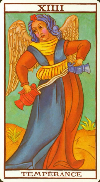
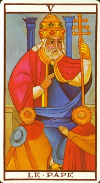
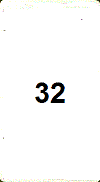









8 + 4 = 12. Male and Female respectively. Uranus is androgynous.
The sex glands are governed by Uranus, and the planet became the new ruler of Aquarius in modern astrology. The gonads of a woman are the ovaries (3, 2) the breasts (20, 21) and the uterus (12). The gonads of a man are the testicles (3, 2) the phallus (7) and the prostrate gland (12) and also the seminal vesicles which I would include as (20, 21).
Uranus, the Latin for Ouranos meaning 'SKY' or 'HEAVEN' was the primordial Greek god of the sky.
Ouranos is the Sky Father the son and husband of Gaia. Every night Ouranos came to cover the Earth and mate with Gaia, but he disliked the children she bore him.
Ouranos banished Gaia's youngest children deep within the bowels of the Earth, where they caused her great pain.
She shaped a flint sickle in secret and asked her sons to overthrow their father, and castrate him. Five of her children ambushed their father, and held him down, while Cronus the youngest and most ambitious of the Titans, castrated him.
He then cast the severed genitals into the sea, creating the goddess of Love, Aphrodite.
The Hanged Man,* is suspended between Heaven and Earth. Looking up at the Sky. He is a Rebel, a Traitor, a disturber of the state and destined to put forward new teaching and new ideas. On the website Uranus, the ruler of the indigoes as the writer states the keywords associated with Uranus are - sudden turns, rebellion, independence, invention, surprises, liberation, disruption, and awakening. In John Sheppard's remarkable book on the tarot, card Twelve, in astrological terms, can be expressed as 'Jupiter in Sagittarius.' The Archer, the sign of Sagittarius was frequently depicted as a centaur, half man, half beast.
*The Hanged Man - 'Sacrifice, surrender, abandonment, renunciation, and transition - S.R. Kaplan.
8 x 4 = 32
The number Thirty-Two is not unlike the puzzle that the number 28 posed. It was difficult to understand what it represented, as the number 32 does not have a specific meaning by itself. Except, the diameter of Uranus happens to be *32,000 miles. After some time, its meaning became clear, and is very subtle and rather elegant. The number 32 is simply 3 and 2 and corresponds with cards 3 and 2 associated with 12. These cards are related to human emotion and the qualities associated with Uranus in regards to the Eleventh House in Astrology. If we add 3 + 2 together we get five, the Hierophant, and by association, card fourteen, the Angel.
3 x 2 = 6 The Lovers, and by association, card fifteen the Devil.
Love and Desire. Kindness and Friendship. - S.R Kaplan.
*If you add card 19 below with 32 you get the same equivalent of 51,000 Kilometers.
The final cards and the maze decoded.



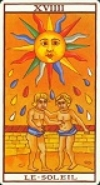






7 + 12 = 19 The Sun, and represents Uranus the planet, bringer of Knowledge.
1 + 9 = 10 The Wheel of Fortune, and represents the rings of Uranus. 1 + 0 = 1. The Wheel of Fortune plus the Magician card equals 11. The number of rings in 2005 until a second outer ring has since been found, and established the number so far, as 13. This was disappointing as everything else was spot on if the other rings had not be so far away to be known about by the Minoans. If however the magician card that equals 11 and we add 1 + 1 equals 2. Then 2 + 11 = 13 the true account is revealed for the two distant outer rings .
1 x 9 = 9 The Hermit, and by association card 18, The Moon, and represents the moons of Uranus, and added together 9 + 18 equals 27. The current, present day count.
On the 4th of November, 2023 another moon has been detected which is the smallest and faintest with a diameter of 5-7 miles by Scott S. Sheppard, now making the official count 28 although there at least 40 objects that could be considered moons.
Ouranos is Mabon - the "Divine Son, Son of Divine Mother" the first God, the first life carved out of the primal void of the divine womb, and banished after Cronus overthrew him, and alluded to in this extract of the spoils of Annwn poem.
'Well-equipped was the prison of Gwair (Mabon) in Caer Sidi
According to the story of Pwyll and Pryderi
None before him went to it,
To the heavy blue chain' it was faithful servant, whom it restrained,
And before the Spoils of Annwn sadly he sang.'
Caer Sidi meaning 'turning' or 'spiral castle' is also associated with the Celtic goddess Arianrhod. She presides over reincarnation, and Caer Sidi is a place of souls which she takes there on her ship the 'Oar Wheel' to reincarnate after eighty years of blissful forgetfulness. The planet Uranus's magnetosphere (watch the video above at about twelve minutes in) is shifted 59 degrees, due to its tilt, see the graph on the left below which causes the field lines of the cylindrical magnetotail to be wound into a corkscrew shape as it moves through space.
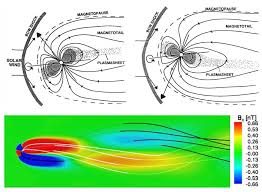

Card Seventeen, The Star shows Persephone bringing back the moisture and fertility to the Earth, and even though this is not one of my cards as part of my equation, the picture for me suggests another meaning just as card twenty-one depicts the snake goddess. Ouranos can be also be portrayed as stars in the heavens, and Persephone represents the constellation Aquarius.
The Minotaur was also called Asterion, 'Starry' when being nursed by his mother Pasiphaë.
'Time is already big by sacred commerce with the timeless courses. Fore-choose and lode-bright, here is the maiden, Equity! The chthonic old sower restores the wastelands. The first-begotten, of the caer of heaven.....would bring his new orient down for our alignment.'
Anathemata, David Jones.
In the Spoils of Annwn poem 'To the heavy blue chain it was faithful servant, whom it restrained,' there is one other interpretation for Blue which is Grey. In Minoan art according to Laura Perry they would use blue for objects that would ordinarily be grey, such as Boulders or Monkey fur, and when you think of chains, I would think of grey rather than blue. Is this one more Minoan echo to the story of Mabon?
What if Arianrhod's name meaning 'Silver Wheel' doesn't refer to the rotation around the pole star, what if silver as a colour tone that looks like grey, and the planets rotation liken to a ball (as shown in the same video on the magnetosphere at 2:30 sec.) rolling through space is her wheel, then Uranus is the 'Silver wheel.'
This would account for Ariadne's Ball of thread, the golden klew, the origin of the English word clue which was used to help Theseus find his way out of the Labyrinth. If the labyrinth is not a maze but a single track, Theseus only had to follow the pathway to find his own way out, why does he need the ball of thread? The ball of thread was also magical, Ariadne would tie one end, and drop the ball, and it would roll of its own accord, unravelling towards the centre, and therefore defining the labyrinth itself with its backward and forward circling, as the planet Uranus, in the same manner, rolling through space with the poles changing position every forty-two years towards the Sun.
I've just come across a theory from Karoly Kerenyi that Ariadne is Persephone, and the 'Lady of the Labyrinth.' Some scholars argued that the Eleusinian mystery cult was a continuation of a Minoan cult, and that Demeter was a poppy goddess who brought the poppy from Crete to Eleusis. The Eleusinian mysteries may have offered an alternative to going to Hades when you died, and these rituals were so secret we are not entirely sure what the initiation entailed. Could it be that the mysteries involved another abode other than the the Elysian fields, which were out of reach to most but all souls presided over by Kronos? Were the Eleusinian mysteries the Greek version of the Celtic Caer Sidi, ruled over by Ouranos for the nobles, artist, poets and warriors, who ordinarily wouldn't get into the Elysian fields unless you were a king or someone of exceptional personage.
The Mabinogion and Mabon.
Ouranos/Uranus as the first God, of the primal void of the divine womb, is the same story of Mabon, which follows in a similar pattern.
No one knows if Mabon is alive or dead,
The grave in upland Nantlleu,
Nobody knows its Properties:
It is Mabon the swift son of Modron.
Nantlleu is the place where Lleu rested while in his spirit form as an Eagle. In an attempt to find him, animals are asked if they know of Mabon, son of Modron. A Black bird is asked, who replies, that he has never heard of him, and directed to speak with a Stag, then an Owl, and then an Eagle, who tells them to seek the Wise salmon, the oldest animal, who has heard cries coming from the walls of a castle at Gloucester, and takes Arthur's men, Cai and Gwrhyr on his shoulders. 'Who is that laments in the house of stone, asks Gwrhyr?' The Salmon responds 'It is Mabon, the son of Modron, who is here imprisoned.'
Mabon is so old that no one remembers, and therefore Immortal. The first god. He is lost, when only three nights old, rather than overthrown by another, with (Gaia) his mothers consent, and imprisoned, just as the Minotaur is also imprisoned within the Labyrinth.
Mabon is also named as the Son of Mellt meaning lightening. I believe that this is an attribute of his own, as Uranus is also associated with Lightening as electricity, and with Earthquakes, as this is one of the reasons I went to Glastonbury to see what was left of the church. The original St. Micheal's church was destroyed by an earthquake in 1275 CE, and was rebuilt in the fourteenth century around 1360 in sandstone until destroyed in 1539 with the dissolution of the monasteries removing all the stone , leaving only the tower. The dedication to St. Michael, the Archangel, was held to hold down the infernal powers, and when you consider the number of buildings destroyed by earthquakes in the United Kingdom, it would seem that this dedication to suppress, the Genius loci of the place, was somewhat unsuccessful.

On the left of card Twelve is card Three, and above is card Twenty-one, and both represent Gaia, as part of the Ouranos myth. On the right is card Two with card Twenty above, and represents the Arianrhod aspect of this God. Card Twenty was originally called the Angel, and also the last card in the sequence of the Tarot before being replaced by the World, and becoming the Christian motif of Judgement and Resurrection. Arianrhod goddess of Reincarnation in Caer Sidi helps Souls prepare with the study of Astrology, to use the stars, and choose the right time to explore a new life and experiences -
Card Two - Wisdom, Sageness, Enlightenment, Knowledge, and Education.
Card Twenty - Revival and reawakening, Rebirth, development and improvement. S.R. Kaplan.
I also came across a website and an article by Dana Corby, she writes -
H.R. Ellis-Davidson quotes the Venerable Bede as translating Modron as the Mothers — plural. Modern translators give it as the Mother — singular. Linguistic evidence may well support the plural interpretation, for although Mabon ap is unequivocally Welsh, Modron may not be: in Germanic languages the singular of Modron becomes Modr — recognizably mother. Suddenly we have, not as was always believed a corruption of the Latin Matrona, but good Germanic, most likely Saxon.'
In the Chartres Cathedral, in France, there is a Medieval Labyrinth, and because it was not a Seven-fold Labyrinth, I didn't understand its relevance to the classical Labyrinth, especially being in a 12th century cathedral. Looking at it now, I can see the overall meaning is still present within the design of the Eleven concentric Rings, split into four parts of 28 loops, (7 x 4 = 28) 7 + 4 = 11) which leads to a Rose with six petals. The Labyrinth is located in the Nave of the Cathedral, and the word Nave (Navis) means 'ship' symbolizing the journey the pilgrim must make in order to arrive at the centre, and the Rose, which is the Lamb, the heavenly Jerusalem, City of God. The Rose is the symbol for the opening of the Vagina. The Rose is the 'Seat and birthplace of god.'
The Cathedral is dedicated to Mary.

Psalms 48: 1-3
Great is the Lord, and greatly to be praised, In the city of our God, His holy mountain. Beautiful in elevation, the joy of the whole earth, Is Mount Zion in the far North, The city of the great King. God, in her palaces, Has made Himself known as a stronghold.
God of the Twisting Path,
God of the Turning Spiral,
God of Revelation,
God of Infinite Mystery; may this God enfold and entwine you in every step.
St. Brigid.
One of the more mysterious additions to this Labyrinth are the marks on the outside edge, which have been referred to as, cups, lunations, cusps, spikes, scallops, teeth or cogs. They have also been considered as part of a Luna calendar, and perhaps their meaning is simpler than this, and the marks are of Minoan symbolism, depicting the 'Horns of Consecrations,' a symbol you find on its own, or in rows on the walls of sacred shrines. At the centre of the Labyrinth there was also a Bronze Plate, which has since been removed, of Theseus and the Minotaur in combat, (which may have been seen as depicting St. Micheal throwing Satan back into the pit) and by removing the plate the goal of the Pilgrim's journey to reach the centre has changed, which is now to reach paradise, the heavenly Jerusalem. The designer of this Labyrinth, must have decided that as a prison for the Minotaur, the Labyrinth is a building, and incorporated this symbol into the design.
Dr. Lauren Artress, a writer on the Chartres Labyrinth, also noticed another Minoan symbol, that of the Labyrs, which looks like an hour glass at the top of the Maze as part of the loops on the turns.


The Horns of Consecration. Labyrs
The Island of Thera was destroyed by a Volcano. This was an underground super volcano which leaves a deep depression (a Caldera) in the ground after the Volcano has ejected all of its Magma, or in this case on the seafloor.
Only recently, since the beginning of the twentieth century, the Island, if looked at now from above, brings to mind a follicle you would see in an Ovary. Stonehenge looks the same, and if viewed with the Avenue as well, it reinforces this impression of of an egg entering a Fallopian tube.
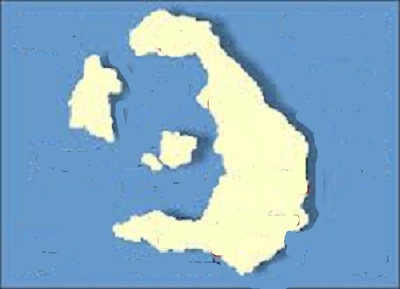
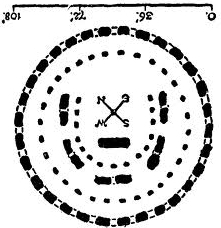
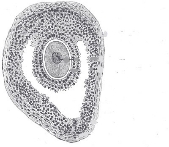
A local women's group of Kathy Jones who had taken up the task to thread the maze, at the prompting of Geoffrey Ashe in a direct way to claim the maze for the Goddess, decided to choose the date of the May full moon, to do this, and climb the Tor. This date was an interesting choice as May day is associated with the Celtic and Saxon fertility gods, such as the Green Man. A ceremony held at Borobudur in Indonesia, where it is also thought the same spiral maze can be found, chose the same date without any direct influence from the group at Glastonbury for their own celebrations.
The Maypole is a goddess symbol of sexuality and fertility. What if this is one of the functions of the Labyrinth, and more than just a prison for the Minotaur. The exact date and origin of the story of the Minotaur is not known, perhaps the Labyrinth is not there for the slaughter of young people, but instead, the Minotaur presided over sex rites as the seven girls and seven boys were not there to die as sacrifices to king Minos as the story later became known for, but were engaged in a ceremony of sacred sexuality.
A Labyrinth, on an Etruscan Oenochoe from Tagliatelle, around 620 BCE, shows horsemen emerging from the Labyrinth (on the outside edge is the word 'Truia' - Troy), with two couples perhaps within the Labyrinth itself engaging in sex, suggesting an association with sacred sexuality.
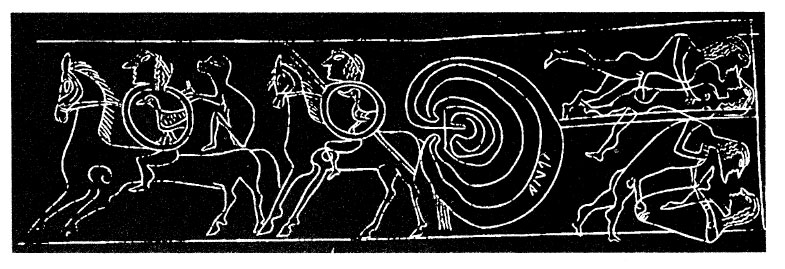
Or, from the Iliad, Homer describes a new shield that Hephaestus is making for Achilles:
'The god depicted a dancing-floor like that Daedalus had designed in the spacious town of Knossos for Ariadne of the lovely locks. Youths and marriageable maidens were dancing on it with there hands on one another's wrists.....Here they ran lightly round, circling as smoothly as a potter.....and they ran in lines to meet each other.'
Could this be a reference to the scene above. People would dance to celebrate the end of the harvest on the circular paved threshing floor. Could the horsemen (carrying shields as warriors rather than farmers, relating to the great military siege against the Greeks) be pulling the couples around the dance floor depicted as the Labyrinth, in the same way as the grain would be threshed using a wooden sled pulled by oxen?

|
The_Threshing_Floor_as_Sacred_Space_in_t.pdf Size : 276.003 Kb Type : pdf |
The above article describes the threshing floor as 'flattened and usually circular surface, made of paving stones or well-beaten earth, sometimes with a low wall running along its edges.' This reminded me of Troy again and the Emperor Nero who as a young man participated in cavalry games.
The fullest description of the exercise is given by Vergil, Aeneid is the final event in the games held to commemorate the anniversary of the death of Aeneas's father Anchises.
'.....And riding side by side. So intricate
In ancient times on mountainous Crete, they say
The labyrinth, between walls in the dark,
Ran criss-cross a bewildering thousand ways
Devised by guile, a maze insoluble,
Breaking down every clue to the way out.
So intricate the drill of Trojan boys
Who wove the patterns of their prancing horses.....'
The article goes on to say 'They are sources of powerful metaphors: important events take place on or near them; and the most sacred biblical place, Solomon's temple, the first permanent dwelling of Yahweh is built over a threshing floor.
Perhaps other places of worship were chosen on the sites that had threshing floors and could explain why the labyrinth is in Chartres cathedral.
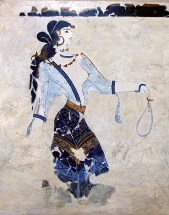
The first time I threaded the maze in 1992, after reaching the top, the heavens opened, and it rained so hard I was forced off the Tor. From reading the Avalonian Quest, I was aware that this was a possibility, as the same thing had happened to the same group of women that had climbed the Tor in May. So I was half expecting this to happen to me as well, which it did. The same thing happened again on my return to Glastonbury in 1996. It was believed at the time that perhaps the goddess's arch-enemy the thunder god was disapproving of the group paying homage to her. By decoding the Labyrinth, and finding Ouranos at the centre, it was not surprising to learn that the etymology of 'Ouranos' essentially means "Rainmaker," his relationship with Mother Earth in order for crops to grow.
I would like to thank Geoffrey Ashe for somewhere to begin unraveling this mystery, and John Sheppard for his book - Tarot Trumps, Cosmos in miniature, and especially Gavin Menzies for his book which finally helped me to bring it to a conclusion. I would also like to thank Caitlin Matthews for her insights on the Mabinogion. My father Kevan Smith who came with me to Glastonbury that day, and introduced me to the Tarot, had unfortunately passed away in 2005.
I would thank him for setting me on this path long before we traveled to Glastonbury.
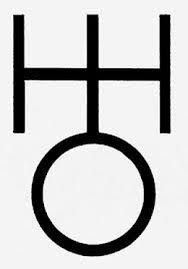
The Sigil, for Uranus was a nod to the Astronomer Sir Frederick William Herschel, using the H in his name, who discovered the planet in 1781 in northern Somerset. Some, point to the cross and the circle below as the upside down sigil for Venus, or Aphrodite, Uranus' daughter.
For me, the sigil reminds me of card 12, the Hanged man.
There is also another symbol for Uranus.
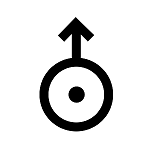
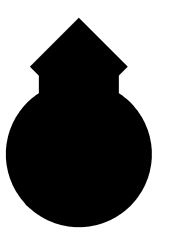
An acquaintance of mine once pointed out that the sun symbol the circle with the dot looks like a breast giving warmth and light to our world, and looking at this symbol the sun with the arrow of Mars above pointing to the sky could be a symbol for the mother and son. I also found a variation of the symbol which surprised me on how easy it brought to mind the tower on the Tor at Glastonbury.
